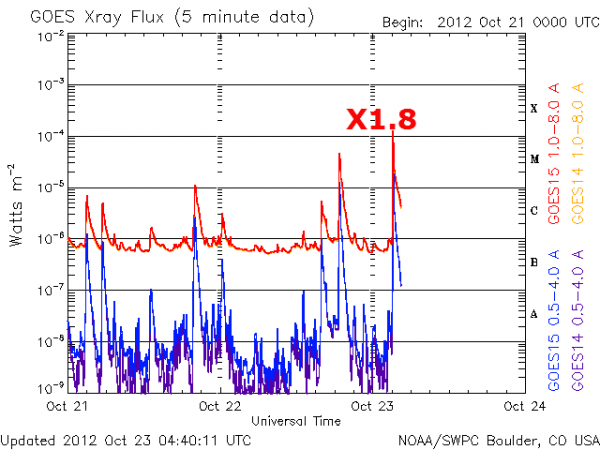

| Visitors Now: | |
| Total Visits: | |
| Total Stories: |
Sunspot 1598 generated impulsive X1.8 solar flare
X1.8 solar flare peaked at 03:17 UTC on October 23, 2012 around Active Region 1598, which is still several days away from directly facing Earth from center disk. NOAA/SWPC forecasters estimated 20% chance for another X-class event.
Space Weather Message Code: SUMX01
Serial Number: 82
Issue Time: 2012 Oct 23 0336 UTC
SUMMARY: X-ray Event exceeded X1
Begin Time: 2012 Oct 23 0313 UTC
Maximum Time: 2012 Oct 23 0317 UTC
End Time: 2012 Oct 23 0321 UTC
X-ray Class: X1.8
Location: S10E53
NOAA Scale: R3 – Strong
Potential Impacts: Area of impact consists of large portions of the sunlit side of Earth, strongest at the sub-solar point.
Radio – Wide area blackout of HF (high frequency) radio communication for about an hour.

Sunspot 1598 produced an impulsive short R3 (Strong) Solar Flare Radio Blackout which can cause wide area blackout of HF radio communication and loss of radio contact for about an hour on sunlit side of Earth as well as low-frequency navigation signals degradation. SpaceWeather.com reports that radiation from the flare created waves of ionization in the upper atmosphere over Asia and Australia.

Generally, short impulsive flares are not associated with severe space weather.
Beside Region 1598, Region 1596 is also moderately sized and has some magnetic complexity, but only managed to produce a small C-class event. The other regions on the disk either remained stable or decayed. There are no large coronal holes on the Earthside of the sun. NOAA/SWPC forecasters estimate 75% chances for M-class solar flares and 20 % for X-class flare.

Solar wind
speed: 366.5 km/sec
density: 2.9 protons/cm3
The Radio Sun
10.7 cm flux: 144 sfu
Interplanetary Mag. Field
Btotal: 2.9 nT
Bz: 2.5 nT south
Related posts:
- Major, Earth directed and long duration X1.4 solar flare erupted from Sunspot 1520 A major and long duration solar flare peaked at 16:52...
- Major solar flare reaching X1.1 peaked at 23:08 UTC As we got used to M-class and waited a day...
Sunspot 1598 generated impulsive X1.8 solar flare
2012-10-23 11:42:26
Source: http://thewatchers.adorraeli.com/2012/10/23/sunspot-1598-generated-x1-8-solar-flare/
Source:



